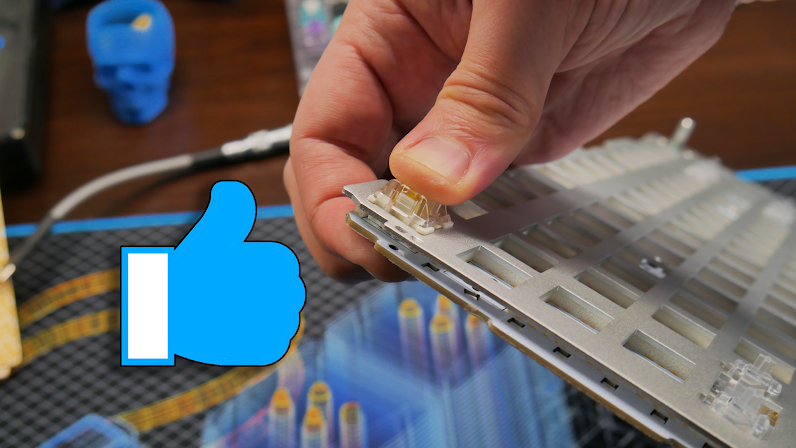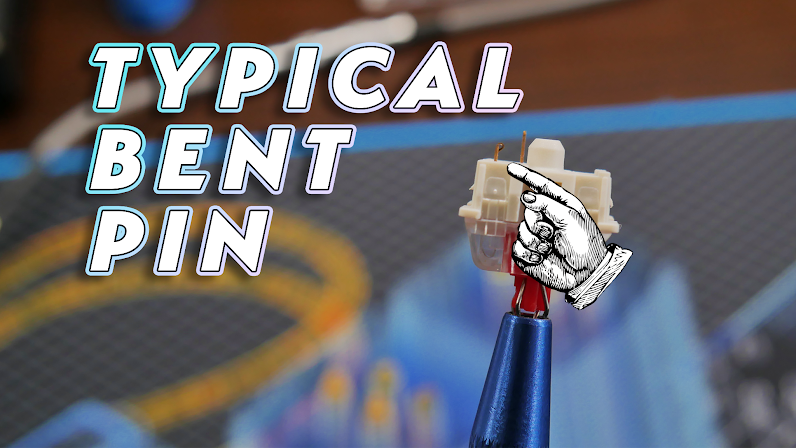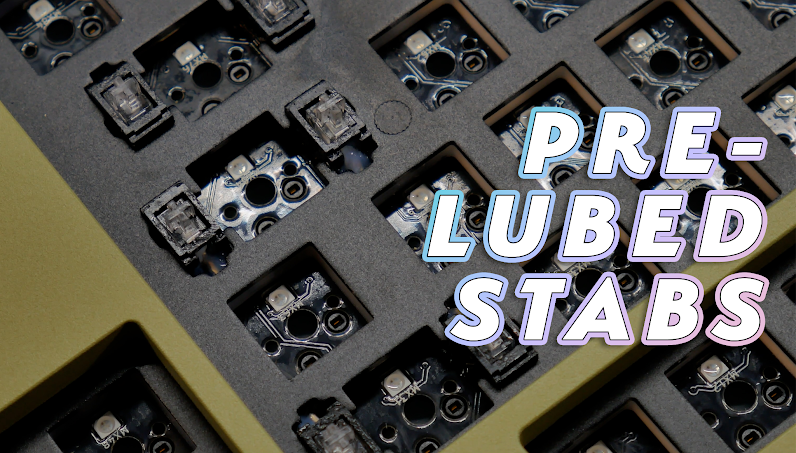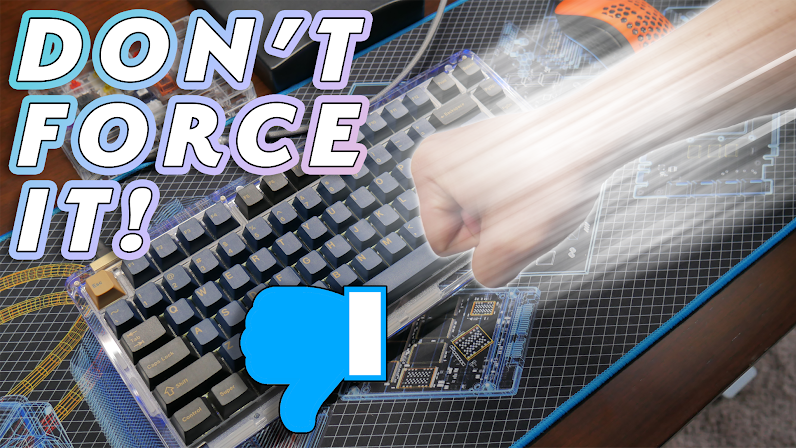Click to view our Accessibility Statement or contact us with accessibility-related questions














Best Practices When Building A Keyboard
I don’t like the phrase “it should go without saying”; if that were the case, there would be so many things that never got mentioned, and a lot of things we’d get wrong because of it. This is also true when building your custom mechanical keyboard: there’s a multitude of best practices out there that can, and will, help guide you towards a cleanly built, good-sounding board and an overall positive experience, provided someone *tells* you what those are. Here are some that “should go without saying”, but will be said anyway for those who are new to the hobby, or just getting back in after some time away!
We’ll be focusing on hotswap mechanical keyboards, as those are by and large the most popular kind of PCB for newcomers and veterans alike, though many of our practices will still apply to soldered builds as well. As always, if there’s anything you feel we missed and would like to add, or need further clarification on, feel free to leave a comment below!
Check All Parts Before Assembly














search
close
Sort by: Newest
keyboard_arrow_down
Durazell
2
Apr 20, 2024
Ok, to be fully honest and transparent. If a keyboard stops working ( keys bind, sticky, get coffee spilled on it ) I buy a new one. I have never once in my long life thought about building a keyboard for me. It all looks very interesting. I have all the tools. I know that much. Just have NO idea where to start. There are so many factors. Bases, switches and stuff I have never heard of. I so badly want to build one. I want to build my own Mechanical very clicky board. Can someone point me in the right direction. I also like the full sized boards. Or at least as close as possible to Full size. I use the Num Pad and arrow keys. All the F keys. I am sure you understand. Please help me out if you can. Loved the article by the way. Some of it a bit over my head right now though. Which is good.

The_Manic_Geek
427
Keyboard Club Member
Jan 19, 2023
Thanks so much for reading our article! As always, if you have any questions, need some clarity, or want to add to the discussion, feel free to... drop... us a comment!
ThereminGoatMK
478
Keyboard Club Member
Feb 8, 2023
The_Manic_GeekI feel misled by this article: I thought soldering everything in before realizing you forgot to put stabilizers in and checking the PCB was how to really build a keyboard. Or at least that's how I've done like half of my builds...
Related Posts
ThereminGoatMK
There Are No Best Switches for Gaming
Figure 1: Nope, not a single one of these is necessarily better than the rest... For no particular reason, I’ve been spending more and more time over the past few months in and around various mechanical keyboard help forums and servers. Despite having never really relied on their services back in my day when I first joined the hobby, I can kind of understand the appeal of them to new and curious enthusiasts as they generally seem like go-to places to connect with people who know a thing or two about keyboards. What I cannot wrap my mind around, however, is the sheer number of times that the exact same comments, questions, or concerns that get raised by the newer hobbyists get repeated. Even with FAQ or pinned set of questions, people seemingly only seem to think about and/or be concerned about the exact same set of things when it comes to their first keyboards. One of these types of questions that I find particularly concerning are those that are directly or indirectly...
Dec 23, 2024

HubertTheMad
How to Introduce the Keyboard Hobby to Others This Holiday Season
Prototype QFRL100 by Thebloodyez with GMK ZX "It's just a keyboard." My Friends, Kate and Jaime’s Expressions After I Explained to Them That There Was Such a Thing as a Keyboard Hobby Many of us have heard this, either stated to us directly by a quizzical individual wondering why on earth we’d find our hobby interesting or as part of someone else’s conversation that we happened to have overheard. While there are certainly less mainstream hobbies than mechanical keyboards, it’s definitely not a common hobby, and it makes sense that those that aren’t in the hobby may not understand “what the point” of having a mechanical keyboard would be. While those same people may still not truly “get it,” even after attempting to explain to them what makes our hobby enjoyable, at least you’ll have introduced them to the hobby, and sometimes a glimmer of curiosity is all that it takes before they start their journey to become a keyboard enthusiast! Especially since it’s the...
Dec 23, 2024
cobertt
Gasket Mounts
A gimmicky hype word, or purposeful implementation, gasket mounting has definitely changed the keyboard landscape. When looking for a new mechanical keyboard, one of the hot terms that come to mind is “gasket mounted”. It’s heavily advertised in the keyboard hobby, but what does it exactly mean? Why is it a buzz term, what are it’s benefits, and does it have any drawbacks? Today we do a deep dive in the world of gasket mount keyboards and what the buzz is all about. Many have seen the keyboard mounting style infographic arranged by Thomas Baart. It’s a great resource, but isn’t quite reflective of the current market. If I had better technical drawing skills, I might attempt a new one. As you can see in the image for the gasket mount, there are red gaskets identified. What isn’t accurate is that the screws for the case travel through the plate or that the plate is sandwiched between the top and bottom case. This would nullify any benefits that gasket mount provides. ...
Dec 13, 2024
ThereminGoatMK
Where Force Curves Don't Quite Measure Up
Figure 1: No, this is not a mistake. This is actually a real force curve I collected... I’ll be the first person in line to swear up and down that force curves are and should be the absolute gold standard of information to have about any mechanical keyboard switch prior to buying them. Even those questionable, hacked together diagrams from manufacturers provide more of an idea about how a switch could or should feel than any sort of buzzword or marketing fluff about them. If you’re serious about buying switches, weird onomatopoeic descriptions or comparisons drawn to other switches just shouldn’t cut it – unless they’re in a longform switch review from your favorite switch reviewer, that is. While many of you probably already have a half decent familiarity with force curves as a result of my introductory article to them here on Drop, as well as my over 1,200 different switches that I’ve collected force curves on to date also thanks to Drop, not many of you probably...
Nov 27, 2024
cobertt
Build-A-Board Workshop
That would be a cool shop to go to in a mall. In some of my past posts and reviews I’ve written there have been requests to walk through my own process for building a keyboard for myself. I’m fortunate in that I get to build many keyboards. I haven’t logged every single keyboard that I’ve built, that would have been great, but hindsight is 20/20. The vast majority of the builds that I do are for other hobbyists. I built a small name for myself doing commissions and build services specializing in leveraging my extensive knowledge of the hobby to help acquire unique boards, make recommendations in build materials, and providing a truly personalized board for those who might not have known much about mechanical keyboards before reaching out to me. I started doing this service back in 2018, and now, being a dad, husband and full time IT specialist, I tend to only accept a couple commissions at a time. I’ve got my own backlog of boards, my collection seems to continually grow, and I...
Oct 15, 2024

storyboardtech
Fink Different: Keyboards as counter-culture.
If you watched Star Wars for the first time, without seeing images of the Empire’s perfectly spaced thousands of goose-stepping minions in spotless white-lacquered armor. If you didn’t see the fleets of black and grey tie-fighters, the immaculately designed star cruisers, the evil moon-shaped flagship… you wouldn’t know that the rebels were rebels. After all, rebels don’t look like rebels if they don’t have something to contrast them against. They just look like normal people. That’s probably why when you see Luke Skywalker, Han Solo or Finn (all rebels) dressed in stormtrooper garb, they somehow seem even more rebellious then they were before. It’s not what they’re wearing, it’s how they wear it. Dirty, scuffed, broken. Helmet missing or askew. An out of place, beat up weapon slung diagonally across their body. It’s the simple act of defacing the uniform that identifies them in our mind as counter-cultural. Funnily enough, it works in reverse. To the dismay of...
Oct 6, 2024
Trending Posts in Mechanical Keyboards
leoakaleo
callboy job chennai
Have you ever considered a profession that blends excitement, charm, and independence? Call boy jobs in Chennai present a unique opportunity for those ready to explore a different career path. With...
Dec 30, 2024
nienow.donny
Chill Out with Fun: Dive into Papa's Freezeria Game!
Are you ready to take a break from reality and indulge in a delicious virtual ice cream adventure? Welcome to the sweet world of Papa's Freezeria! In this delightful game, you'll transform into a master ice cream chef, serving up yummy concoctions to your quirky customers while managing your very own ice cream shop. Grab your aprons, unleash your creativity, and get ready to scoop, blend, and serve! What is Papa's Freezeria? Papa's Freezeria is a fun-filled cooking simulation game where players run an ice cream parlor by preparing and serving delicious treats. From building the perfect sundae to creating refreshing milkshakes, this game brings the art of ice cream making right to your fingertips! But hold on—having fun isn’t just about tasty flavors; it’s also about mastering the art of multitasking and keeping your customers happy. How to Play: Your Guide to Delicious Success! Step 1: Get Started Getting started is easy! You can choose between various characters, each with their...
Dec 30, 2024
MoreBlcvk
Can i someone support me in fixing my Drop Alt keyboard?
I havent used this keyboard in months. When I plug it in, it turns on and turns off. You would assume there is a short in the cord but I know there's not because I can use the cord with a different keyboard. So do you think its a firmware issue or a short inside the keyboard? Either way I want to fix it. Any suggestions or tips & tricks?
Dec 29, 2024
CapnKitten
Solid ABS Keycaps
DCX quality is pretty good. Similar sound signature and a smoother texture to GMK. Not a dig at either, just a difference. Ignore the missing keycap, it's a switch issue.
Dec 29, 2024

excelsiorcarslondon
Why Cab Service Near Me is Essential in Today’s Fast-Paced World
In today’s world, convenience is key. Whether you're commuting to work, heading to an important meeting, or enjoying a night out, having access to a reliable london city airport transfers is indispensable. Companies like Excelsior Cars London are redefining what it means to travel conveniently and efficiently. The Importance of Local Cab Services When you're in a hurry or unfamiliar with your surroundings, searching for a “cab service near me” can be a lifesaver. Local cab services bridge the gap between affordability and reliability, providing quick solutions for transportation needs. Unlike app-based ride-sharing platforms, traditional cab services often offer: Instant Availability: No long wait times during peak hours. Knowledgeable Drivers: Drivers familiar with local routes and shortcuts. Personalized Service: A customer-focused experience that prioritizes your comfort. Excelsior Cars London, for example, ensures passengers experience stress-free travel with their fleet of...
Dec 27, 2024










